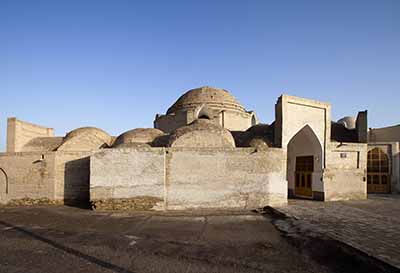Uzbekistan | Bukhara | Abdullah Khan Tim | Carpets

I left the northern entrance to Tok-i-Tilpak Furushon and proceeded along Shah Restan Street 430 feet to the entrance of the Abdullah Khan Tim on the right. While a trading bazaar with several entrances, like Trade Dome #1 and Trade Dome #2 , are called tok , a trade arcade with only one entrance is known as a tim . At one time there were at least six tim on this street, plus numerous other bazaars and caravanserais. The Abdullah Khan Tim, the only one now remaining, was built in 1577 by the Shaybinid Abdullah Khan . Once it was one of Bukhara’s most upscale trading venues, specializing in high-quality silk and wool goods. At least fifty small trading booths, many manned by Afghani traders, lined the interior. The center of the tim now serves as a spacious carpet store. Shah Restan Street, with the entrance to the Abdullah Khan Tim right of center and the Tok-i-Tilpak Furushon (Trade Dome #2) just visible at the end of the street. Entrance to Abdullah Khan Tim...


